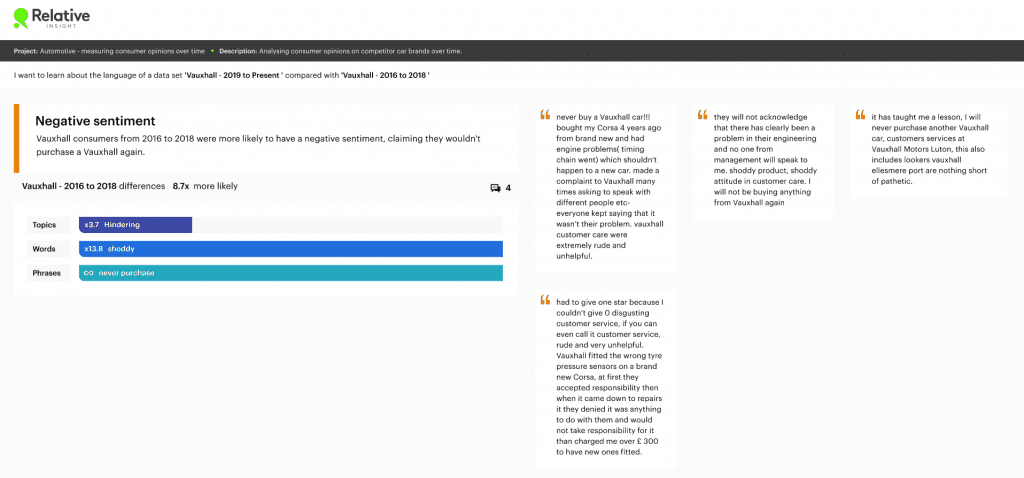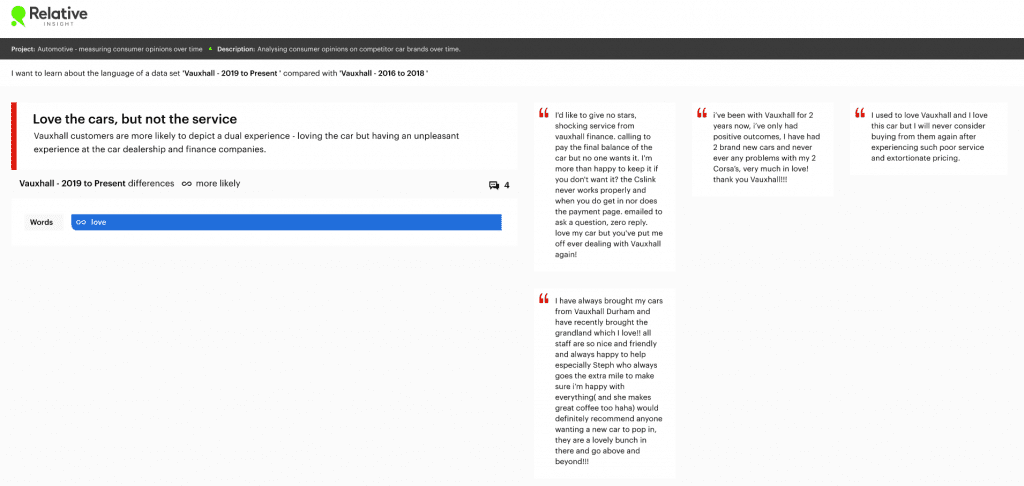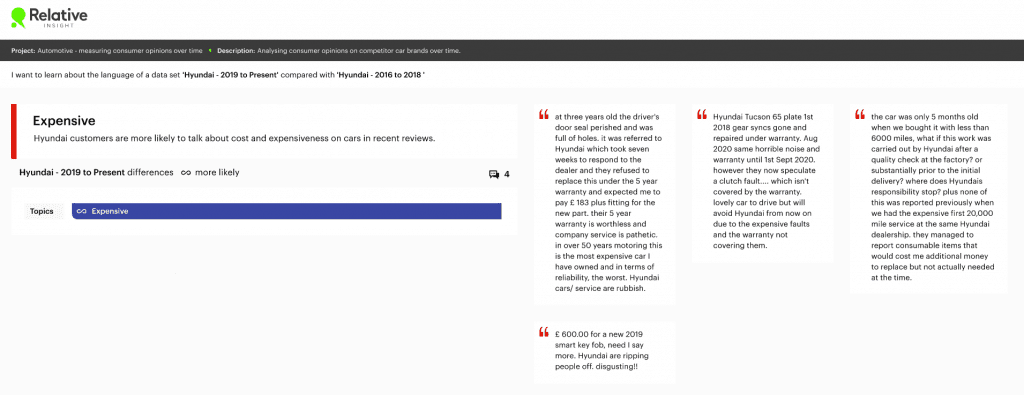Tracking changes in Vauxhall and Hyundai brand perception over time

Since the birth of the “Motorwagen” in 1886, cars have become a necessity of modern life. But as brands bring out newer models, transition to electric and introduce autonomous driving technology, how is brand perception of car manufacturers changing? What exactly causes a brand’s value to grow or diminish in the eyes of the consumer?
Automotive brands are using Relative Insight to generate a variety of different customer insights examples by analyzing customer review data and tracking how consumer opinions change over time. Analyzing customer feedback can be a crucial source of intel for entire organizations, benefitting product development teams, marketing efforts and customer support professionals.
For this customer insights analysis, we looked at the review data of two popular automotive brands: Vauxhall and Hyundai. Firstly, we gathered Trustpilot reviews for both brands. We then uploaded this qualitative data to the Relative Insight platform, and split it by timestamp to create two periods to compare:
- Vauxhall reviews 2016 to 2018 vs 2019 to 2021
- Hyundai reviews 2016 to 2018 vs 2019 to 2021
Relative Insight is a customer insights tool that utilizes text analytics to slice and dice your data in different ways. Our comparative methodology reveals the drivers of satisfaction and dissatisfaction and enables brands to track consumer insights over time.
Vauxhall brand perception
Vauxhall reviews – 2016 to 2018
Between 2016 and 2018, Vauxhall consumers were 10.3x more likely to talk about Vauxhall’s lifetime warranty. The lifetime warranty caused confusion amongst consumers, who didn’t exactly know what was covered, claiming they had still been charged for repairs.
Our analysis found that between 2016 and 2018, Vauxhall consumers were more likely to have a negative attitude towards the brand highlighted by the phrase never purchase. Bad customer experiences had clearly led to negative brand perception of Vauxhall, with customers using the word shoddy to describe both the product and customer care.

Vauxhall reviews – 2019 to 2021
In contrast, Vauxhall reviews from 2019 to 2021 were more likely to depict a dual experience. Customers were infinitely more likely to use the word love throughout their reviews, a powerful adjective with clear positive associations.

However, this was often in the context that customers loved the car but had unpleasant experiences with the car dealership, customer service and third-party finance companies. Vauxhall reviews were twice as likely to include words such as email, phone, call and informed, with customers expressing frustration at a lack of help across these channels. Vauxhall should focus their efforts on improving customer service to ensure that the love people have for their products is also reflected for the general brand.
Hyundai Brand perception
Hyundai reviews – 2016 to 2018
Looking at Hyundai brand perception reviews from 2016 to 2018, our analysis revealed that customers were 7.2x more likely to discuss issues with their car’s battery. Although a major problem for customers at the time, the greater relative difference suggests that this issue wasn’t as prevalent in recent years. However, having a way of tracking customer reviews in real-time would have enabled Hyundai to spot this trend and take an active response.

During this time frame, Hyundai reviewers were also more likely to talk about disrespectful encounters at car dealerships. Words such as impolite and rude appeared 9x more in this data set. This highlights how the actions of employees has ultimately impacted Hyundai brand perception. In the automotive industry, communicating with customers at a dealership is key to encourage sales and ensure customer satisfaction. Therefore, consistency in behavior and alignment to brand image is of the utmost importance.

Hyundai reviews – 2019 to 2021
When we look at Hyundai reviews from 2019 to 2021, a key insight was that customers were infinitely more likely to talk about cost and expensiveness of vehicle faults and repairs. This suggests that value is a key factor when purchasing a new car and highlights how consumers are naturally concerned about the extra costs of car maintenance.

Tracking brand perception and customer feedback over time enables organizations to spot trends and reveal the drivers of customer dissatisfaction that explain why consumer attitudes have changed. With this knowledge, brands can understand how they can improve customer experience, increase consumer loyalty and measure the impact of marketing efforts or product updates.
